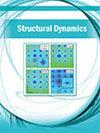结合阴离子对法老藻盐视紫红质结构和动力学的影响
IF 2.3
2区 物理与天体物理
Q3 CHEMISTRY, PHYSICAL
引用次数: 3
摘要
跨膜的主动离子传输对于维持细胞中离子的电化学梯度至关重要,并且是由跨膜蛋白介导的。盐视紫红质(HR)起到了光驱动的氯离子向内泵的作用。该蛋白质包含通过质子化的席夫碱与特定赖氨酸残基结合的所有反式视网膜。结合的氯离子和质子化的希夫碱之间的相互作用对离子传输至关重要,因为氯离子的运动是由质子化希夫碱在光异构化时的翻转驱动的。然而,这种相互作用在HR光循环中是如何演变的仍然是未知的。在这里,我们讨论了在光循环的早期阶段,结合阴离子对法老纳氏菌HR的结构和动力学的影响。氯化物结合、甲酸盐结合和阴离子贫化形式的比较提供了对结合阴离子和发色团/蛋白质部分之间相互作用的见解。在未光解状态下,结合的阴离子影响多烯链的π-共轭和视网膜发色团的质子化希夫碱的氢键。皮秒时标测量表明,在甲酸盐结合形式的光激发下,色氨酸残基的W16和W18模式的能带强度瞬间降低。相反,氯化物结合和阴离子贫化形式的这些强度降低被延迟。这些观察结果表明,结合的甲酸根离子与视网膜发色团和发色团口袋的相互作用更强。在纳秒到微秒的时间尺度上,我们发现质子化的希夫碱和结合离子之间的相互作用在K中间体形成时被破坏,并且在结合阴离子向L中间体中的质子化希夫碱转移后被恢复。我们的结果表明,结合阴离子的氢键能力在光驱动阴离子泵的离子传输中起着至关重要的作用。本文章由计算机程序翻译,如有差异,请以英文原文为准。
Effect of a bound anion on the structure and dynamics of halorhodopsin from Natronomonas pharaonis
Active ion transport across membranes is vital to maintaining the electrochemical gradients of ions in cells and is mediated by transmembrane proteins. Halorhodopsin (HR) functions as a light-driven inward pump for chloride ions. The protein contains all-trans-retinal bound to a specific lysine residue through a protonated Schiff base. Interaction between the bound chloride ion and the protonated Schiff base is crucial for ion transport because chloride ion movement is driven by the flipping of the protonated Schiff base upon photoisomerization. However, it remains unknown how this interaction evolves in the HR photocycle. Here, we addressed the effect of the bound anion on the structure and dynamics of HR from Natronomonas pharaonis in the early stage of the photocycle. Comparison of the chloride-bound, formate-bound, and anion-depleted forms provided insights into the interaction between the bound anion and the chromophore/protein moiety. In the unphotolyzed state, the bound anion affects the π-conjugation of the polyene chain and the hydrogen bond of the protonated Schiff base of the retinal chromophore. Picosecond time scale measurements showed that the band intensities of the W16 and W18 modes of the tryptophan residues decreased instantaneously upon photoexcitation of the formate-bound form. In contrast, these intensity decreases were delayed for the chloride-bound and anion-depleted forms. These observations suggest the stronger interactions of the bound formate ion with the retinal chromophore and the chromophore pocket. On the nanosecond to microsecond timescales, we found that the interaction between the protonated Schiff base and the bound ion is broken upon formation of the K intermediate and is recovered following translocation of the bound anion toward the protonated Schiff base in the L intermediate. Our results demonstrate that the hydrogen-bonding ability of the bound anion plays an essential role in the ion transport of light-driven anion pumps.
求助全文
通过发布文献求助,成功后即可免费获取论文全文。
去求助
来源期刊

Structural Dynamics-Us
CHEMISTRY, PHYSICALPHYSICS, ATOMIC, MOLECU-PHYSICS, ATOMIC, MOLECULAR & CHEMICAL
CiteScore
5.50
自引率
3.60%
发文量
24
审稿时长
16 weeks
期刊介绍:
Structural Dynamics focuses on the recent developments in experimental and theoretical methods and techniques that allow a visualization of the electronic and geometric structural changes in real time of chemical, biological, and condensed-matter systems. The community of scientists and engineers working on structural dynamics in such diverse systems often use similar instrumentation and methods.
The journal welcomes articles dealing with fundamental problems of electronic and structural dynamics that are tackled by new methods, such as:
Time-resolved X-ray and electron diffraction and scattering,
Coherent diffractive imaging,
Time-resolved X-ray spectroscopies (absorption, emission, resonant inelastic scattering, etc.),
Time-resolved electron energy loss spectroscopy (EELS) and electron microscopy,
Time-resolved photoelectron spectroscopies (UPS, XPS, ARPES, etc.),
Multidimensional spectroscopies in the infrared, the visible and the ultraviolet,
Nonlinear spectroscopies in the VUV, the soft and the hard X-ray domains,
Theory and computational methods and algorithms for the analysis and description of structuraldynamics and their associated experimental signals.
These new methods are enabled by new instrumentation, such as:
X-ray free electron lasers, which provide flux, coherence, and time resolution,
New sources of ultrashort electron pulses,
New sources of ultrashort vacuum ultraviolet (VUV) to hard X-ray pulses, such as high-harmonic generation (HHG) sources or plasma-based sources,
New sources of ultrashort infrared and terahertz (THz) radiation,
New detectors for X-rays and electrons,
New sample handling and delivery schemes,
New computational capabilities.
 求助内容:
求助内容: 应助结果提醒方式:
应助结果提醒方式:


